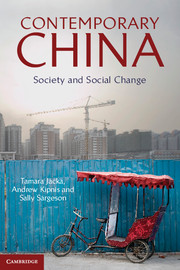Book contents
- Frontmatter
- Contents
- List of Images
- List of Maps
- List of Figures
- List of Tables
- Acknowledgments
- List of Abbreviations
- Map 0.1: China's provinces and provincial capitals
- Introduction
- Part 1 Social Institutions
- 1 Families, Kinship and Relatedness
- 2 Marriage, Intimacy and Sex
- 3 Citizenship, Household Registration and Migration
- 4 Community Institutions
- 5 Work
- Part 2 Cultures, Socialization and the Formation of Identities
- Part 3 Inequalities, Injustices and Social Responses
- Glossary of Chinese Terms
- References
- Index
4 - Community Institutions
Published online by Cambridge University Press: 05 June 2014
- Frontmatter
- Contents
- List of Images
- List of Maps
- List of Figures
- List of Tables
- Acknowledgments
- List of Abbreviations
- Map 0.1: China's provinces and provincial capitals
- Introduction
- Part 1 Social Institutions
- 1 Families, Kinship and Relatedness
- 2 Marriage, Intimacy and Sex
- 3 Citizenship, Household Registration and Migration
- 4 Community Institutions
- 5 Work
- Part 2 Cultures, Socialization and the Formation of Identities
- Part 3 Inequalities, Injustices and Social Responses
- Glossary of Chinese Terms
- References
- Index
Summary
What is a “community”? Sociologists offer many different answers to this question. The 19th-century German sociologist Ferdinand Tönnies, for example, treated community (gemeinschaft) as an organic collection of people, knit together by territory, kinship, labor, shared customs, and a sense of belonging. Tönnies contrasted community, exemplified by what he imagined to be the unchanging kinship and neighborly relations of agricultural village life, with the new, artificial forms of association created in urban industrial societies. Scholars later criticized this view, arguing that communities have always occurred along a rural–urban continuum and exhibited varying levels of interdependence, internal differentiation and dynamism. More recent research highlights non-territorial social, symbolic and political constructions of community, and its normative force.
Each of these arguments has been applied to explain rules, norms and ways of being a community in China. Fei Xiaotong wrote that connections between villages illustrated the “interdependence of territorial groups, especially in economic life”, while William Skinner argued that historically, villages were not closed territorial groups and that the openness of village communities and their interdependence with other social entities correlated with cycles of dynastic overthrow and consolidation, and with changes of government. In the 1950s, the state's organization of a centrally planned economy and efforts to revolutionize property and work created what Vivienne Shue has described as a “cellular” political and economic structure, like a honeycomb.
- Type
- Chapter
- Information
- Contemporary ChinaSociety and Social Change, pp. 83 - 104Publisher: Cambridge University PressPrint publication year: 2013



